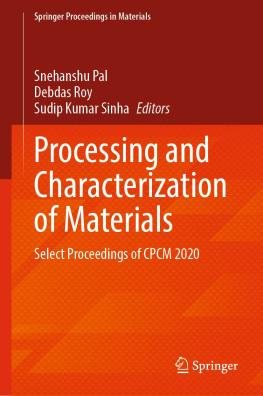Energy Systems in Electrical Engineering
Series Editor
Muhammad H. Rashid
Florida Polytechnic University, Lakeland, USA
More information about this series at http://www.springer.com/series/13509
Shanky Saxena , Ritu Sharma and B. D. Pant
Design and Development of MEMS based Guided Beam Type Piezoelectric Energy Harvester
1st ed. 2021

Logo of the publisher
Shanky Saxena
School of Electronics and Electrical Engineering, Lovely Professional University, Phagwara, Punjab, India
Ritu Sharma
Department of Electronics and Communication Engineering, Malaviya National Institute of Technology, Jaipur, Rajasthan, India
B. D. Pant
Council of Scientific and Industrial Research, Central Electronics Engineering Research Institute, Pilani, Rajasthan, India
ISSN 2199-8582 e-ISSN 2199-8590
Energy Systems in Electrical Engineering
ISBN 978-981-16-0605-2 e-ISBN 978-981-16-0606-9
https://doi.org/10.1007/978-981-16-0606-9
The Editor(s) (if applicable) and The Author(s), under exclusive license to Springer Nature Singapore Pte Ltd. 2021
This work is subject to copyright. All rights are solely and exclusively licensed by the Publisher, whether the whole or part of the material is concerned, specifically the rights of translation, reprinting, reuse of illustrations, recitation, broadcasting, reproduction on microfilms or in any other physical way, and transmission or information storage and retrieval, electronic adaptation, computer software, or by similar or dissimilar methodology now known or hereafter developed.
The use of general descriptive names, registered names, trademarks, service marks, etc. in this publication does not imply, even in the absence of a specific statement, that such names are exempt from the relevant protective laws and regulations and therefore free for general use.
The publisher, the authors and the editors are safe to assume that the advice and information in this book are believed to be true and accurate at the date of publication. Neither the publisher nor the authors or the editors give a warranty, expressed or implied, with respect to the material contained herein or for any errors or omissions that may have been made. The publisher remains neutral with regard to jurisdictional claims in published maps and institutional affiliations.
This Springer imprint is published by the registered company Springer Nature Singapore Pte Ltd.
The registered company address is: 152 Beach Road, #21-01/04 Gateway East, Singapore 189721, Singapore
This book is dedicated to my parents Mr. Anil Kumar Saxena and Mrs. Raagni Saxena for their continuous support and inspiration to pursue my interests in science. This book is also dedicated to my late grandparents Mr. P. L. Saxena, Mrs. Satyawati Saxena, Mr. M. C. Saxena and Mrs. Sharda Saxena for their love and encouragement in all my endeavors.
Shanky Saxena
Foreword
In the current race of miniaturization of microelectronic circuits and systems, the power required by these systems particularly by the Wireless Sensor Networks (WSNs) has reduced to a very low level. WSNs consist of many Mobile sensor nodes (MSNs) which are driven by miniaturized lithium-ion batteries that are exhaustible and replacement is not feasible at remote locations. Energy harvesting provides an unending power source that is adequate to power these sensor nodes specifically for remote area applications. Energy harvester can convert freely available ambient energy into electrical energy to provide an endless source of power for MSNs. In Microelectromechanical system (MEMS) based energy harvesters, electrical and mechanical components are integrated into a single device, making them tiny and compact which is suitable for remote area applications. MEMS-based piezoelectric vibration energy harvesters are a preferred choice because of their simplicity in design, operation, and compatibility with fabrication technology. The realization of cantilever-based piezoelectric energy harvesters has always been challenging because great care is required to develop and characterize each unit process leading to the technology development for the fabrication of a specific device.
This monograph is focused on MEMS-based piezoelectric vibration energy harvesters. State of the art technologies have been reviewed to understand the available technologies suitable for vibration energy harvesting. Analytical equations governing the device key parameters have been introduced in the initial portion of the monograph. Simulation steps have been presented using snapshots and results have been depicted by graphs making it easy to comprehend. In the later section of the monograph, a detailed fabrication process on the development of micromachining processes based on both wet and dry etching techniques has been discussed. Elaborate structural, material, morphological, topological, dynamic, and electrical characterization of the device has been presented. In the last section, a real-time practical application is selected, and a piezoelectric energy harvester is designed which is suitable to operate in the desired environment.
My compliments to the authors for putting together this valuable contribution in the form of a monograph which would be of interest and use to graduate students and researchers alike.
Muhammad Mustafa Hussain Fellow, IEEE, APS and IoP
January 2021
Preface
The internet of things (IoT) is a network embedded with sensors, software and other technologies that allow to transmit and receive data. Increased use of sensors in IoT imposes a challenge to power these sensors operating at remote locations. The use of Lithium-ion batteries is not sustainable as they are not environment friendly and requires timely replacement. Energy harvesting is a technology that converts freely available ambient energy into electrical energy. Vibration energy harvesting is preferred because vibrations of different amplitude and frequency are freely available in the environment. Piezoelectric type vibration energy harvesters are prominently used due to their simple operation and compatibility with MEMS fabrication technology. Cantilever structure fixed from one end and free from the other are widely used to realize a Piezoelectric vibration energy harvester.
In this monograph, a fixed-fixed or guided beam Piezoelectric Vibration Energy Harvester has been designed, fabricated and tested for low-frequency operation. Device design has been done ensuring low-frequency operation, stable and reliable device operation and higher potential generation. Single beam, Cantilever array and guided beam structures have been designed and investigated using FEM. Fabrication technology is one of the most significant steps in the realization of a device. Guided two-beam and four-beam piezoelectric energy harvester devices have been fabricated. In both of these devices, a combination of wet and dry bulk micromachining techniques has been utilized. Aqueous TMAH etching for wet bulk micromachining, RIE (reactive ion etching) and DRIE (deep reactive ion etching) for dry bulk micromachining processes have been used.











